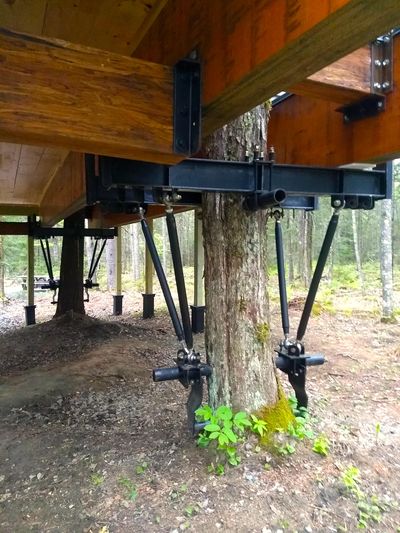Ask the Builder: Building a treehouse for adults

Q: Tim, I was spending a lazy weekend afternoon gazing at countless photos of actual treehouses that one could live in, and I was intrigued and am seriously thinking of building one. Mind you, I’m not talking about some little box kids might play in and use as a clubhouse. I’m talking a real two-bedroom home with everything you’d have in a home that’s built on a typical foundation on the ground. What’s involved in making this happen? Is it foolhardy? Will the house get damaged in a windstorm? – Becky S., Rockfall, Conn.
A: Have you spent a dreamy afternoon or two as Becky did? I know I have. About 10 years ago, after first moving to New Hampshire, I thought about building a separate tiny structure up on a giant piece of exposed granite on my land. My oldest daughter had shown me a stunning photo of an enclosed deck surrounded by giant glass windows. The caption of the photo called it a lantern room.
I was mesmerized with this concept and went so far as to seriously think about building a two-room structure surrounded by nothing but glass. After a few days, the magic wore off. It’s a good thing because it would have been a nightmare to get to it in snowy weather, much less to heat it in the winter.
An entire industry has blossomed because of folks like Becky. You absolutely can build a treehouse, a real house surrounding a single tree or suspended in between three or more trees. Wind is your biggest enemy when it comes to treehouses. Trees sway back and forth in heavy winds.
A well-engineered treehouse will not be damaged in windstorms because it will float on a suspension system that’s connected to the trees. There are all sorts of such systems, and it’s going to require quite a bit of research as well as field trips to see which one you feel will work best. If you were to bolt the house support beams directly to the trees, the wind would tear the house apart as it stretches and squeezes the house.
Before you get too involved in the project, the first person I’d consult with would be a certified arborist. I’d want to know if the trees I’m thinking of working with are strong, disease-resistant and well-suited for holding up a house for 50 or more years. I know for a fact not all trees are equal, and some are far weaker than others. I’d want to know how fast the diameter of the tree increases so the ones supporting the house don’t start to get too close to the exterior finishes.
Once I knew the trees would work, I’d then travel to see no fewer than five actual treehouses and talk with the owners. Most are proud of their structures and will almost always share details of their trials and tribulations. You can even stay in one for a weekend, as I have in Downeast Maine. I highly recommend looking online for treehouses that you can rent for a night or weekend. Take lots of photos to see what you like and don’t like. Pay attention to how the house was connected to the trees and how all the utilities stretch up from the ground into the house.
Be aware that your construction costs are very likely going to be higher than those for a normal house. The builder will face all sorts of challenges working up in and around the trees that will undoubtedly slow him down. Address this topic with the owners of the treehouses you visit. You can diplomatically talk about this by speaking in generalities and ranges of prices.
One of your biggest challenges will be finding a builder who can do the job. My guess is very few builders have built a treehouse. It’s OK to use a builder who has not done one, but he needs to be extremely detail-oriented and to prove that he has completed other projects that had very unique engineering challenges that he overcame. Go visit those projects and talk with the homeowners. Do not simply trust what the builder tells you. There’s too much at risk.
You also can watch any number of online videos about treehouse construction and the types of suspension systems available. Pay attention to all the products used and try to locate videos showing the methods the builders used to work up in the air. Scaffolding comes to mind, but your wooded situation might not be such a friendly place for pipe scaffolding.
Lastly, you should give serious consideration to all the exterior materials. Think about future maintenance. Imagine how much effort it might be to paint the house or do other things to keep the exterior in excellent shape.
This project will require an enormous amount of preplanning and due diligence if you don’t want your dream to transform into a nightmare. Take plenty of time to parse all the parts of your vision so you don’t overlook something that will keep you awake at night.
Subscribe to Carter’s free newsletter and listen to his new podcasts at askthebuilder.com.